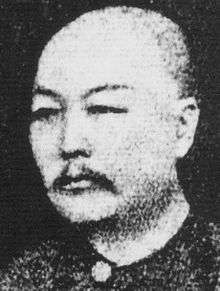Hoo Ah Kay

Hoo Ah Kay (simplified Chinese: 胡亚基; traditional Chinese: 胡亞基; pinyin: Hú Yà Jī; 1816 - 27 March 1880), C.M.G, better known as Whampoa (黃埔), was a Singaporean businessman. An immigrant to Singapore from China, he held many high-ranking posts in Singapore, including honourable consul to Japan, Russia and China.
Early life
Hoo Ah Kay (Hu Hsuan-tse[1]) was born 1816, in Whampoa, near Canton (now known as Huangpu district, Guangzhou city) in China.[2] He immigrated to Singapore in 1830.[3] Initially working with his businessman father at food supplier Whampoa and Co., Hoo inherited the establishment after his father died.[4]
Career
Better known as Whampoa,[2] Hoo is cited as both "the first Japanese honorable consul in Singapore" and "the first Chinese consul [in Singapore]", two posts he was given in 1879 and 1877 respectively.[5] In 1869, Hoo was announced as the first Legislative Council member of Chinese ethnicity by the British,[6] albeit an unofficial one.[7] He was also a retail dealer specialising in ships working for the British Royal Navy.[4] For a period of time he ran a business supplying ice imported from the United States to Singapore; it folded in 1856.[8] Hoo was hailed as "one of the most influential Chinese (Cantonese) tycoons in Singapore".[9] He was awarded the Order of St Michael and St George, Class Companion (CMG).[10] In 1869, he became the first Asian member of the Legislative Council and within a few years was made an extraordinary member of the Executive Council, the only Chinese to have held this position.[11]
Personal life
Hoo was described as having led a rich and glamorous lifestyle, occasionally organising elaborate meals, mostly intended for overseas visitors. He would hire many dancers to perform for him, as well as personal servants to fan him, as depicted in an illustration by English painter Edward Cree.[4] He also owned a few race horses; one of them reportedly earned him about a hundred thousand dollars.[12] Hoo frequently let the public at large visit his residence,[13] which was depicted as sprawling with lush greenery.[14] Despite being eloquent in the English language, he maintained a Chinese personality, preferring to wear Chinese robes. Hoo had a son, who he sent to Britain for education; when his son snipped off his ponytail and turned into a Christian, Hoo was written to have been "outraged".[15]
Death
Hoo Ah Kay died on 27 March 1880, aged 64.[3] Whampoa Road in Novena, Singapore is named after him.
Popular culture
- Hoo Ah Kay appears in George MacDonald Fraser's historical novel Flashman's Lady.
References
- ↑ Godley 2002, p. 217.
- 1 2 Godley 2002, p. 67.
- 1 2 "Business Giants from the Singapore River". Edumall. Retrieved 26 May 2013.
- 1 2 3 Pilon, Maxime (2012). The French in Singapore: An Illustrated History (1819–today). Editions Didier Millet. pp. 43–. ISBN 9789814260442.
- ↑ Ooi, Keat Gin (2004). Southeast Asia: A Historical Encyclopedia, from Angkor Wat to Timor. R–Z. 3. ABC-CLIO. p. 681. ISBN 9781576077702.
- ↑ Godley 2002, p. 68.
- ↑ Corfield, Justin (2010). Historical Dictionary of Singapore. Scarecrow Press. pp. 57–. ISBN 9780810873872.
- ↑ Baker, James Michael (2005). The eagle in the Lion City: America, Americans and Singapore. Landmark Books. pp. 45–. ISBN 9789814189040.
- ↑ Takashi, Shiraishi (1993). The Japanese in colonial Southeast Asia. SEAP. pp. 13–. ISBN 9780877274025.
- ↑ Tarling, Nicholas (2010). Studies in the Social History of China and South-East Asia: Essays in Memory of Victor Purcell. Cambridge University Press. p. 257. ISBN 9780521133746.
- ↑ Zangger, Andreas (2013). The Swiss in Singapore. Didier Millet. p. 37. ISBN 9814385689.
- ↑ Mangan, James A. (2003). Sport in Asian Society: Past and Present. Routledge. pp. 72–. ISBN 9780714653426.
- ↑ Thiam, Derek (2007). Singapore in Global History. Amsterdam University Press. p. 156. ISBN 9789048514373.
- ↑ Warren, William (2000). Singapore: City of Gardens. Tuttle. p. 75. ISBN 9789625931555.
- ↑ Marshall, P.J. (2001). The Cambridge Illustrated History of the British Empire. Cambridge University Press. p. 292. ISBN 9780521002547.
Bibliography
- Godley, Michael R. (2002). The Mandarin-Capitalists from Nanyang: Overseas Chinese Enterprise in the Modernisation of China 1893–1911. Cambridge University Press. ISBN 9780521526951.